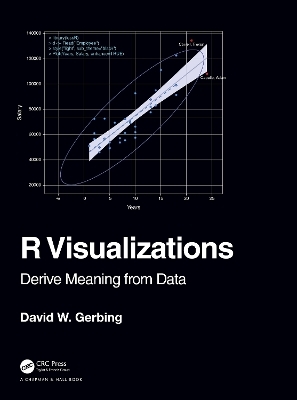
R Visualizations
CRC Press (Verlag)
978-1-138-59963-5 (ISBN)
R Visualizations: Derive Meaning from Data focuses on one of the two major topics of data analytics: data visualization, a.k.a., computer graphics. In the book, major R systems for visualization are discussed, organized by topic and not by system. Anyone doing data analysis will be shown how to use R to generate any of the basic visualizations with the R visualization systems. Further, this book introduces the author’s lessR system, which always can accomplish a visualization with less coding than the use of other systems, sometimes dramatically so, and also provides accompanying statistical analyses.
Key Features
Presents thorough coverage of the leading R visualization system, ggplot2.
Gives specific guidance on using base R graphics to attain visualizations of the same quality as those provided by ggplot2.
Shows how to create a wide range of data visualizations: distributions of categorical and continuous variables, many types of scatterplots including with a third variable, time series, and maps.
Inclusion of the various approaches to R graphics organized by topic instead of by system.
Presents the recent work on interactive visualization in R.
David W. Gerbing received his PhD from Michigan State University in 1979 in quantitative analysis, and currently is a professor of quantitative analysis in the School of Business at Portland State University. He has published extensively in the social and behavioral sciences with a focus on quantitative methods. His lessR package has been in development since 2009.
David W. Gerbing has a Quantitative Methods B.A. from Western Washington State College, and M.A. from Michigan State University, and a Ph.D. from Michigan State University. Dr. Gerbing teaches statistics, quantitative methods, and business research techniques. His research interests are in the areas of quantitative analysis, multivariate statistics, and behavioral measurement and assessment. Currently his primary interest is in the increasing the accessibility of the R programming language for data science so that non-programmers can access the free, open source data analysis system without a steep learning curve.
1. R, Data and Visualizations. 2. R Visualization Quick Start. 3. Customization. 4. Visualize the Distribution of a Categorical Variable. 5. Visualize the Distribution of a Continuous Variable. 6. Visualize the Distributions of Values over Time. 7. Visualize Spatial Data with Maps. 8. Visualize Three Dimensions. 9 Visualize Dimensionality Reduction. 10. Interactive Visualizations.
| Erscheinungsdatum | 15.05.2020 |
|---|---|
| Zusatzinfo | 6 Tables, black and white; 100 Illustrations, black and white |
| Verlagsort | London |
| Sprache | englisch |
| Maße | 210 x 280 mm |
| Gewicht | 834 g |
| Themenwelt | Mathematik / Informatik ► Informatik ► Theorie / Studium |
| Mathematik / Informatik ► Mathematik ► Computerprogramme / Computeralgebra | |
| ISBN-10 | 1-138-59963-8 / 1138599638 |
| ISBN-13 | 978-1-138-59963-5 / 9781138599635 |
| Zustand | Neuware |
| Informationen gemäß Produktsicherheitsverordnung (GPSR) | |
| Haben Sie eine Frage zum Produkt? |
aus dem Bereich


